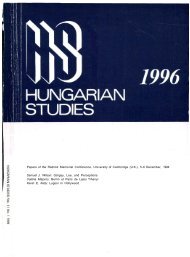The Canadian-American Review of Hungarian Studies - Vol. 4 ... - EPA
The Canadian-American Review of Hungarian Studies - Vol. 4 ... - EPA
The Canadian-American Review of Hungarian Studies - Vol. 4 ... - EPA
You also want an ePaper? Increase the reach of your titles
YUMPU automatically turns print PDFs into web optimized ePapers that Google loves.
While some <strong>of</strong> the groups have been seriously exposed to the propaganda<strong>of</strong> Communism and Fascism, and a minority among them haveeven succumbed to such external pressure, the majority, by reason <strong>of</strong>these very attempts at penetration, are all the better aware <strong>of</strong> thechallenge to democracy and liberty involved in the rise <strong>of</strong> Hitler. 39New <strong>Canadian</strong>s in general, and <strong>Hungarian</strong>-<strong>Canadian</strong>s in particular,were fortunate during the war to have had a spokesman like Kirkconnell.Popularizing New <strong>Canadian</strong> LiteraturesStill another way in which Pr<strong>of</strong>essor Kirkconnell assisted <strong>Canadian</strong>s<strong>of</strong> European background was to encourage and popularize the works <strong>of</strong>immigrant poets and writers. He himself discovered the richness <strong>of</strong> thevirtually unknown non-English and non-French <strong>Canadian</strong> literaturealmost by accident. <strong>Canadian</strong> texts <strong>of</strong> literary history and criticismnever even mentioned works written in other than English or French.<strong>The</strong> country's immigrants were presumed to have no literary tradition<strong>of</strong> their own. But Kirkconnell found that a section <strong>of</strong> Wesley College'slibrary was filled with books and journals written in Icelandic, producedby authors in both Iceland and Canada. Further investigationrevealed that much Icelandic poetry had been written by members <strong>of</strong>Manitoba's compact little Icelandic community. Later, when Kirkconnellacquainted himself with some <strong>of</strong> the city's other ethnic groups,he realized that Winnipeg's Magyars, Ukrainians, Poles, Swedes, Norwegians,Germans, Greeks, and Italians were also creating their "considerableliteratures." 40<strong>The</strong> discovery <strong>of</strong> a new, wealthy branch <strong>of</strong> <strong>Canadian</strong> literatureprompted Kirkconnell to study New <strong>Canadian</strong> letters systematically.He began to amass his own collection <strong>of</strong> literature produced byCanada's European immigrants, to seek out their poets and writers, andto start accumulating biographical and bibliographical information onthem. In 1935 he published an anthology <strong>of</strong> New <strong>Canadian</strong> poetry, to befollowed by a series <strong>of</strong> studies on New <strong>Canadian</strong> belles lettres, publishedmainly in the University <strong>of</strong> Toronto Quarterly. In his memoirs, Pr<strong>of</strong>essorKirkconnell evaluated the literature <strong>of</strong> New <strong>Canadian</strong>s as follows:Taken together, these minor literatures present an unrivalled picture <strong>of</strong>human predicament, <strong>of</strong> lives uprooted from a country and plantedafresh with difficulty in <strong>Canadian</strong> soil. 41<strong>The</strong> volume <strong>of</strong> this literature was so extensive that, by the time he retired
















